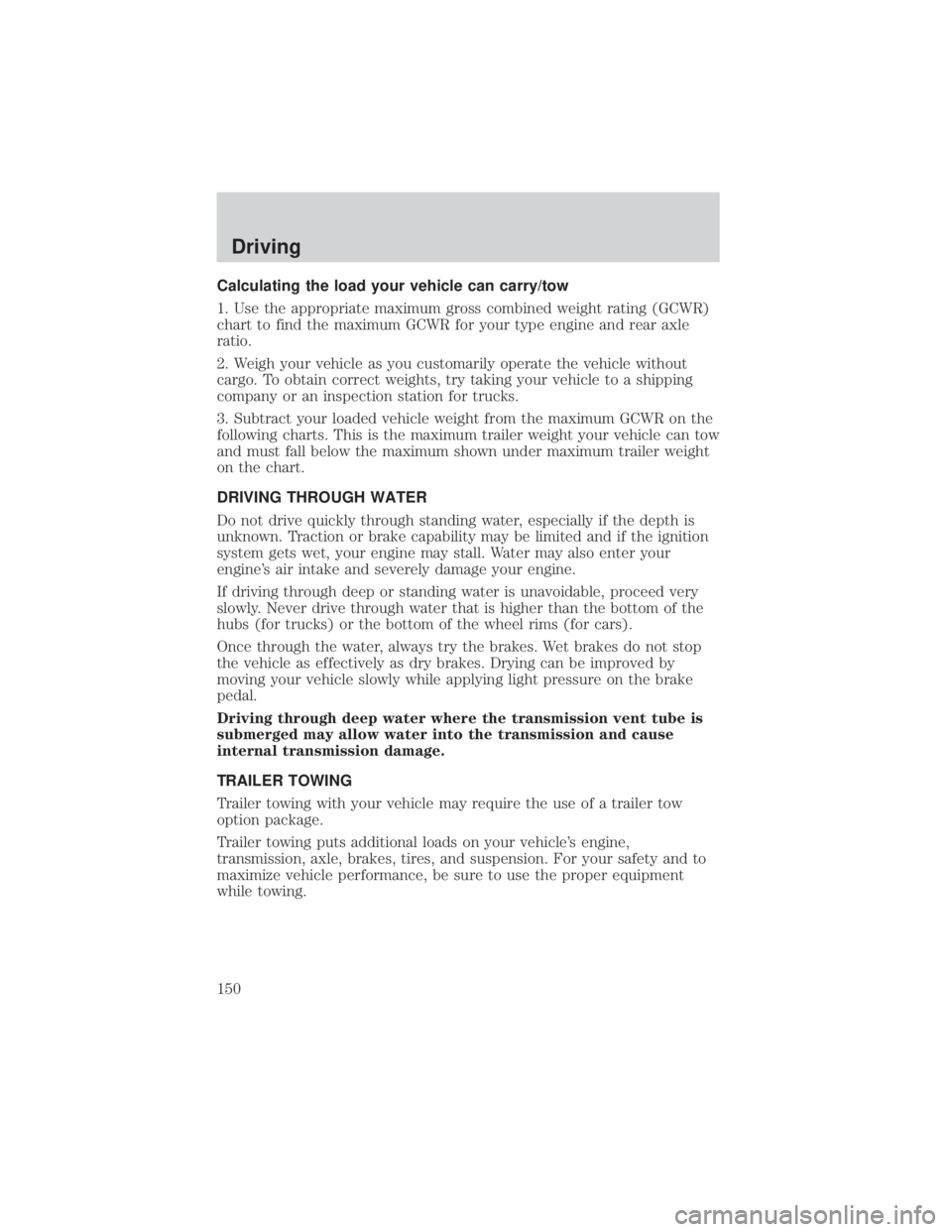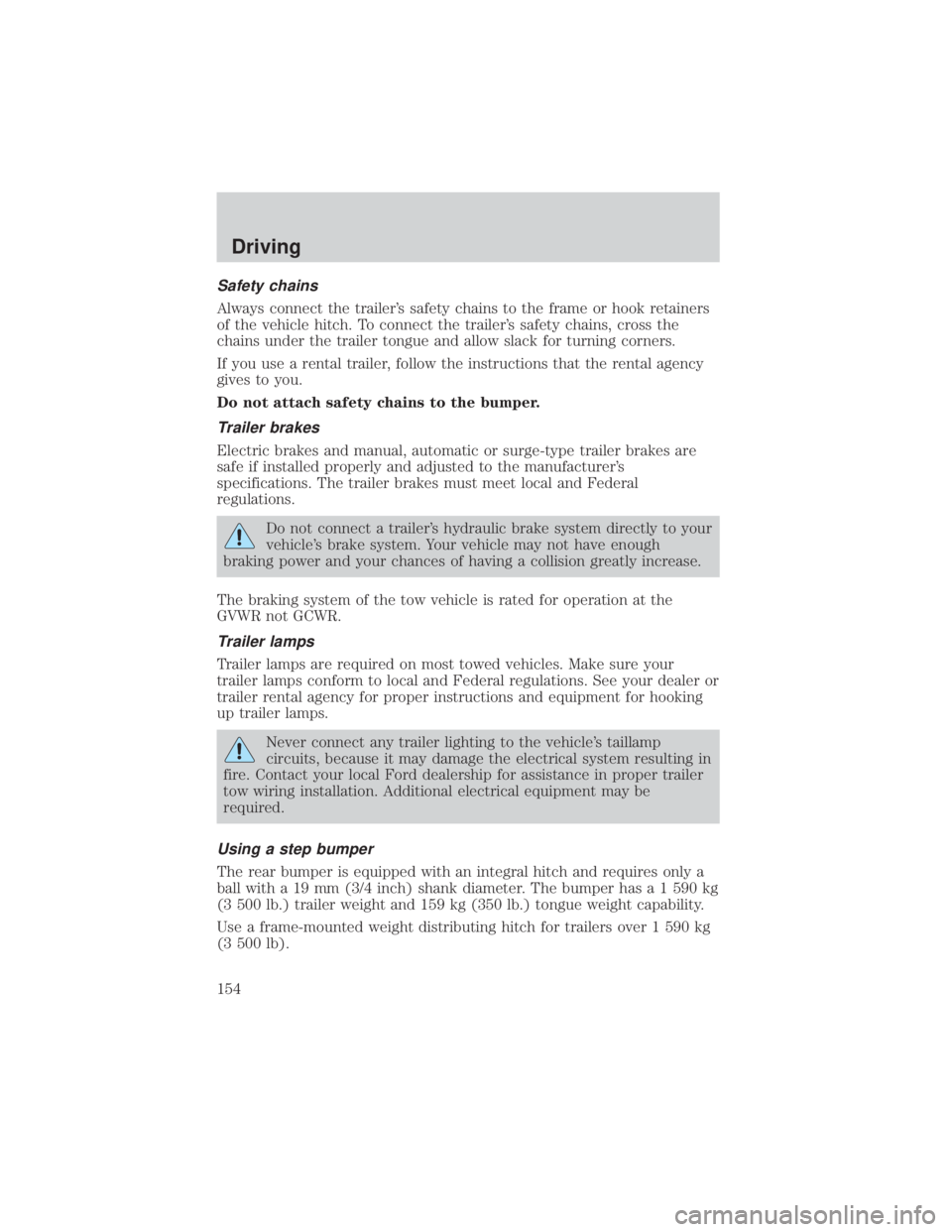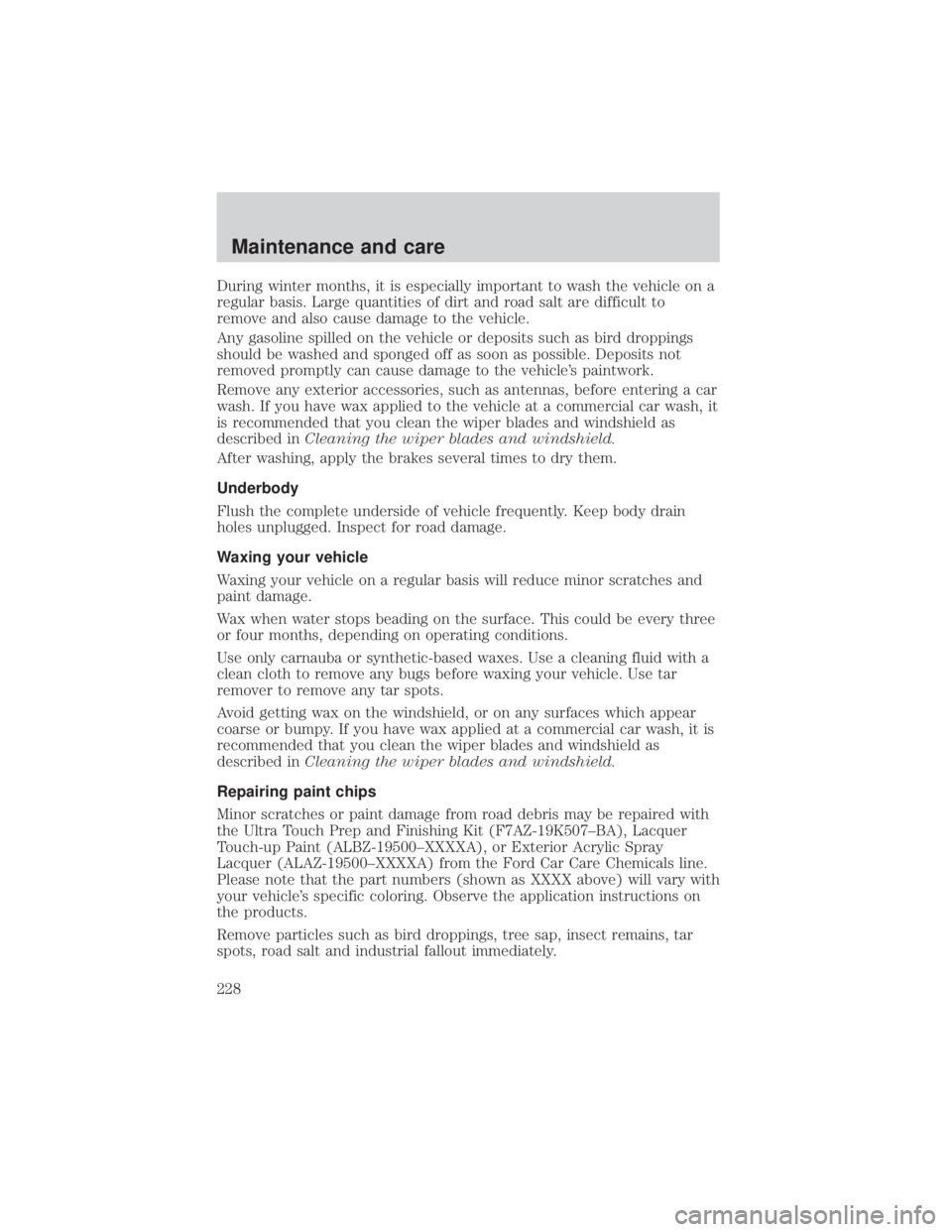2001 FORD EXPLORER SPORT TRAC brakes
[x] Cancel search: brakesPage 150 of 264

Calculating the load your vehicle can carry/tow
1. Use the appropriate maximum gross combined weight rating (GCWR)
chart to find the maximum GCWR for your type engine and rear axle
ratio.
2. Weigh your vehicle as you customarily operate the vehicle without
cargo. To obtain correct weights, try taking your vehicle to a shipping
company or an inspection station for trucks.
3. Subtract your loaded vehicle weight from the maximum GCWR on the
following charts. This is the maximum trailer weight your vehicle can tow
and must fall below the maximum shown under maximum trailer weight
on the chart.
DRIVING THROUGH WATER
Do not drive quickly through standing water, especially if the depth is
unknown. Traction or brake capability may be limited and if the ignition
system gets wet, your engine may stall. Water may also enter your
engine's air intake and severely damage your engine.
If driving through deep or standing water is unavoidable, proceed very
slowly. Never drive through water that is higher than the bottom of the
hubs (for trucks) or the bottom of the wheel rims (for cars).
Once through the water, always try the brakes. Wet brakes do not stop
the vehicle as effectively as dry brakes. Drying can be improved by
moving your vehicle slowly while applying light pressure on the brake
pedal.
Driving through deep water where the transmission vent tube is
submerged may allow water into the transmission and cause
internal transmission damage.
TRAILER TOWING
Trailer towing with your vehicle may require the use of a trailer tow
option package.
Trailer towing puts additional loads on your vehicle's engine,
transmission, axle, brakes, tires, and suspension. For your safety and to
maximize vehicle performance, be sure to use the proper equipment
while towing.
Driving
150
Page 154 of 264

Safety chains
Always connect the trailer's safety chains to the frame or hook retainers
of the vehicle hitch. To connect the trailer's safety chains, cross the
chains under the trailer tongue and allow slack for turning corners.
If you use a rental trailer, follow the instructions that the rental agency
gives to you.
Do not attach safety chains to the bumper.
Trailer brakes
Electric brakes and manual, automatic or surge-type trailer brakes are
safe if installed properly and adjusted to the manufacturer's
specifications. The trailer brakes must meet local and Federal
regulations.
Do not connect a trailer's hydraulic brake system directly to your
vehicle's brake system. Your vehicle may not have enough
braking power and your chances of having a collision greatly increase.
The braking system of the tow vehicle is rated for operation at the
GVWR not GCWR.
Trailer lamps
Trailer lamps are required on most towed vehicles. Make sure your
trailer lamps conform to local and Federal regulations. See your dealer or
trailer rental agency for proper instructions and equipment for hooking
up trailer lamps.
Never connect any trailer lighting to the vehicle's taillamp
circuits, because it may damage the electrical system resulting in
fire. Contact your local Ford dealership for assistance in proper trailer
tow wiring installation. Additional electrical equipment may be
required.
Using a step bumper
The rear bumper is equipped with an integral hitch and requires only a
ball with a 19 mm (3/4 inch) shank diameter. The bumper has a 1 590 kg
(3 500 lb.) trailer weight and 159 kg (350 lb.) tongue weight capability.
Use a frame-mounted weight distributing hitch for trailers over 1 590 kg
(3 500 lb).
Driving
154
Page 188 of 264

BRAKE FLUID
Checking and adding brake fluid
Brake fluid should be checked and
refilled as needed. Refer to the
scheduled maintenance guide for
the service interval schedules.
1. Clean the reservoir cap before
removal to prevent dirt or water
from entering the reservoir.
2. Visually inspect the fluid level.
3. If necessary, add brake fluid from
a clean un-opened container until
the level reaches MAX. Do not fill
above this line.
4. Use only a DOT 3 brake fluid
certified to meet Ford specification ESA-M6C25±A. Refer toLubricant
specificationsin theCapacities and specificationschapter.
Brake fluid is toxic. If brake fluid contacts the eyes, flush eyes
with running water for 15 minutes. Seek medical attention if
irritation persists. If taken internally, drink water and induce vomiting.
Seek medical attention immediately.
If you use a brake fluid that is not DOT 3, you will cause
permanent damage to your brakes.
Do not let the reservoir for the master cylinder run dry. This
may cause the brakes to fail.
MAX
Maintenance and care
188
Page 228 of 264

During winter months, it is especially important to wash the vehicle on a
regular basis. Large quantities of dirt and road salt are difficult to
remove and also cause damage to the vehicle.
Any gasoline spilled on the vehicle or deposits such as bird droppings
should be washed and sponged off as soon as possible. Deposits not
removed promptly can cause damage to the vehicle's paintwork.
Remove any exterior accessories, such as antennas, before entering a car
wash. If you have wax applied to the vehicle at a commercial car wash, it
is recommended that you clean the wiper blades and windshield as
described inCleaning the wiper blades and windshield.
After washing, apply the brakes several times to dry them.
Underbody
Flush the complete underside of vehicle frequently. Keep body drain
holes unplugged. Inspect for road damage.
Waxing your vehicle
Waxing your vehicle on a regular basis will reduce minor scratches and
paint damage.
Wax when water stops beading on the surface. This could be every three
or four months, depending on operating conditions.
Use only carnauba or synthetic-based waxes. Use a cleaning fluid with a
clean cloth to remove any bugs before waxing your vehicle. Use tar
remover to remove any tar spots.
Avoid getting wax on the windshield, or on any surfaces which appear
coarse or bumpy. If you have wax applied at a commercial car wash, it is
recommended that you clean the wiper blades and windshield as
described inCleaning the wiper blades and windshield.
Repairing paint chips
Minor scratches or paint damage from road debris may be repaired with
the Ultra Touch Prep and Finishing Kit (F7AZ-19K507±BA), Lacquer
Touch-up Paint (ALBZ-19500±XXXXA), or Exterior Acrylic Spray
Lacquer (ALAZ-19500±XXXXA) from the Ford Car Care Chemicals line.
Please note that the part numbers (shown as XXXX above) will vary with
your vehicle's specific coloring. Observe the application instructions on
the products.
Remove particles such as bird droppings, tree sap, insect remains, tar
spots, road salt and industrial fallout immediately.
Maintenance and care
228
Page 254 of 264

A
Air bag supplemental restraint
system ........................................112
and child safety seats ............114
description ..............................112
disposal ....................................117
driver air bag ..........................115
indicator light ...................10, 117
operation .................................115
passenger air bag ...................115
Air cleaner filter ...............190, 233
Air conditioning ..........................20
rear seat controls .....................23
Ambulance packages ....................3
Antifreeze (see Engine
coolant) .....................................191
Anti-lock brake system (see
Brakes) ..............................132±133
Anti-theft system
warning light .............................11
Audio system (see Radio) .........27
Automatic transmission ............136
driving an automatic
overdrive .................................137
fluid, adding ............................196
fluid, checking ........................196
fluid, refill capacities ..............233
fluid, specification ..................238
Auxiliary power point .................73
Axle
lubricant specifications ..235, 238
refill capacities ........................233
traction lok ..............................135
B
Battery .......................................200acid, treating emergencies .....200
charging system
warning light .............................11
jumping a disabled battery ....174
maintenance-free ....................200
replacement, specifications ...233
servicing ..................................200
voltage gauge ............................16
Belt minder ...............................108
Brakes ........................................132
anti-lock ...........................132±133
anti-lock brake system
(ABS) warning light .........10, 133
brake warning light ..................10
fluid, checking and adding ....188
fluid, refill capacities ..............233
fluid, specifications .........235, 238
lubricant specifications ..235, 238
parking ....................................133
shift interlock ..........................136
Break-in period .............................3
C
Capacities for refilling fluids ....233
Cargo cage ...................................76
Cassette tape player ...................37
Certification Label ....................240
Child safety restraints ..............118
child safety belts ....................118
Child safety seats ......................119
attaching with tether straps ..124
in front seat ............................121
in rear seat ......................121, 123
Cleaning your vehicle ...............227
engine compartment ..............229
exterior ............................228, 232
exterior lamps .........................230
Index
254
Page 257 of 264

driving with a heavy load ......148
location ....................................148
H
Hazard flashers .........................159
Head restraints .....................96, 99
Headlamps ...................................18
aiming ..............................225±226
bulb specifications ..................224
daytime running lights .............18
flash to pass ..............................19
high beam ...........................11, 19
replacing bulbs .......................221
turning on and off ....................18
warning chime ..........................13
Heating ........................................20
heating and air conditioning
system .......................................20
Hood ..........................................183
I
Ignition .................................56, 238
Infant seats
(see Safety seats) .....................119
Inspection/maintenance (I/M)
testing ........................................220
Instrument panel
cleaning ...................................230
cluster ..................................8, 231
lighting up panel and
interior .......................................19
location of components ..............8
J
Jack ............................................168
positioning ...............................168storage .....................................168
Jump-starting your vehicle ......174
K
Keyless entry system .................88
autolock .....................................91
keypad .......................................88
locking and unlocking doors ....90
programming entry code .........89
Keys .......................................92±94
key in ignition chime ...............13
positions of the ignition ...........56
L
Lamps
bulb replacement
specifications chart ................224
cargo lamps ...............................19
daytime running light ...............18
fog lamps ...................................18
headlamps .................................18
headlamps, flash to pass ..........19
instrument panel, dimming .....19
interior lamps ...................67, 225
replacing bulbs ...............220±224
Lane change indicator
(see Turn signal) ........................55
Lights, warning and indicator ......8
air bag ........................................10
anti-lock brakes (ABS) ....10, 133
anti-theft ...................................11
brake ..........................................10
charging system ........................11
check coolant ............................11
check engine ...............................8
cruise indicator .........................13
door ajar ....................................12
fuel cap light ...............................9
Index
257